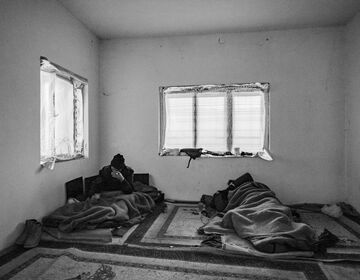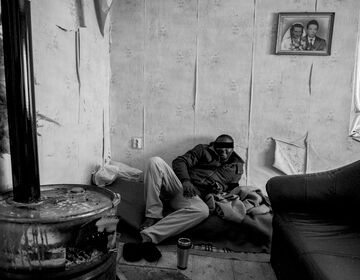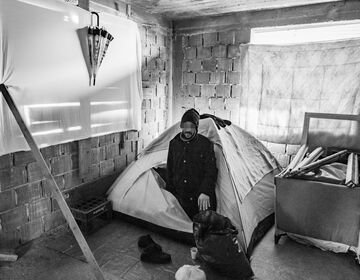
layover-sarajevo-feature-_CHL044020-20cadus20sarajevo20bosnia202018-9f4b2677
Layover Sarajevo
A photo report by Christoph Löffler about fleeing and shelter for the 18th International Migrants Day.
Explanatory notes about the attempt to help people.
And an implicit call for donations.
The Balkan route, an escape route for many people from Morocco and Algeria. For most of the people who embark on this arduous journey, the road ends at the Croatian border.
There is talk of so-called PushBacks, that is, collective turning backs without examining the individual circumstances of the individuals concerned, which would amount to a violation of the European Convention on Human Rights.1
Sent back to Bosnia and stranded i.a. in Sarajevo, many of the refugees have to stay on the street. A small network of organizations builds makeshift sleeping facilities in the city itself. In early December, there were still 25 so-called squats in which the people are housed. They are not official lodgings but home-made rooms in dilapidated houses or in construction ruins.Windows were provisionally repaired with Plexiglas panes and construction foam to protect from the cold. There are no doors in the houses and blankets or cut carpets take on this role. The group AidBrigade organizes homemade ovens and installs them to keep the small rooms warm. Thick smoke is lingering in many of the rooms. Wood was funded by donations and is regularly distributed to the various squats. Electricity and sanitary facilities are in vain. The houses do not suffice for that. Sporadically, washrooms can be found in the squats, in cold rooms in the houses. To cook for yourself is a wishful dream.
Employees of BASIS Bosnia interview the newly arrived in the individual houses and ask about their experiences on the route and what happened to them on their trip to the EU. Many report from Push-Backs and experiences with the Croatian police. Stopped by warning shots in the air and detained afterwards, their mobile phones stolen or destroyed to prevent that they can orient themselves via GPS. Some report physical violence and others tell that their sleeping bags have been taken away. BasisBosnia asks them, in addition to their experiences on the journey, whether the refugees have warm shoes, enough winter clothing, if they need more warm blankets for the cold night or if they want to seek medical assistance.
I was allowed to accompany the organization in their evaluation in some of the squats. I asked people if I could tell about their situation and capture it with a photo. The reactions were different. Many did not want them to be photographed in such an intimate or "dishonorable" situation. Others took it easy and enjoyed my interest/me being there as a photographer.
Sarajevo is a beautiful city. The short ways through the city on the way to the lodgings draw a diverse and cozy cityscape. "Allah is the greatest" verses from the minarets turn into church chimes of other places. Many architectural styles can be found in the city. From old half-timbered houses in the old town to imposing prefabricated buildings, everything is visible. After a very rainy night you can hope for a good view. Hope that the smog has disappeared for a day. For a picturesque picture of the mountains surrounding the city and a wide river flowing through the valley.
Everywhere in the city you can see traces of the war. Bullet holes in houses are not uncommon. The population is very supportive towards the fleeing persons. A resident dentist offers his help and works closely with CADUS e.V. to provide treatment for those suffering from toothache. A fabric dealer based in Sarajevo has agreed to sew warm sleeping bags and sell them for the purchase price to BASIS Bosnia for distribution to the ones in need.
Something is stirring the city up. Some parts of the population support the stuck people. They understand it, they probably also have first-hand experience of what war and flight can mean.
Without the organizations like BASIS Bosnia, AidBrigade and volunteers from the city Sarajevo would have most likely been in the news with very different headlines. Sadly, this is still a possibility as the flow of human beings is not decreasing.
CADUS e.V. also contributes with medical help. So that solidary work no longer needs to be. So that the stories told by my photos will soon belong to the past.
1.) ARD Tagesschau report from 16.12.2018 – / https://www.tagesschau.de/multimedia/video/video-484113.html
all photos: Christoph Löffler, pictures from different squats in Sarajevo, Bosnia-Herzegovina December 2018
Published
Author: by Jonas Grünwald
By CADUS-PR
Stay informed about our missions, events and humanitarian emergency aid topics – with our newsletter!
Newsletter registration
I want to unsubscribe from the newsletter.















